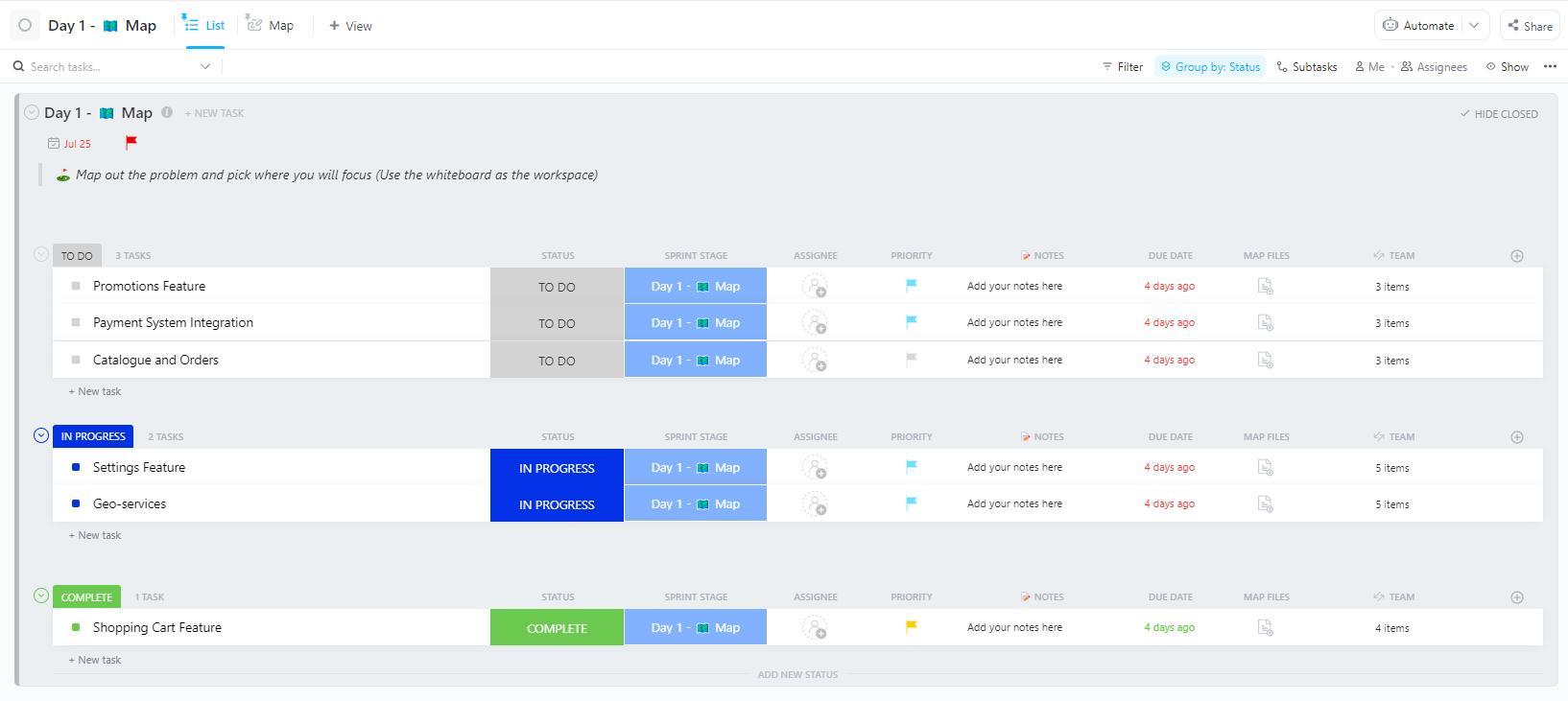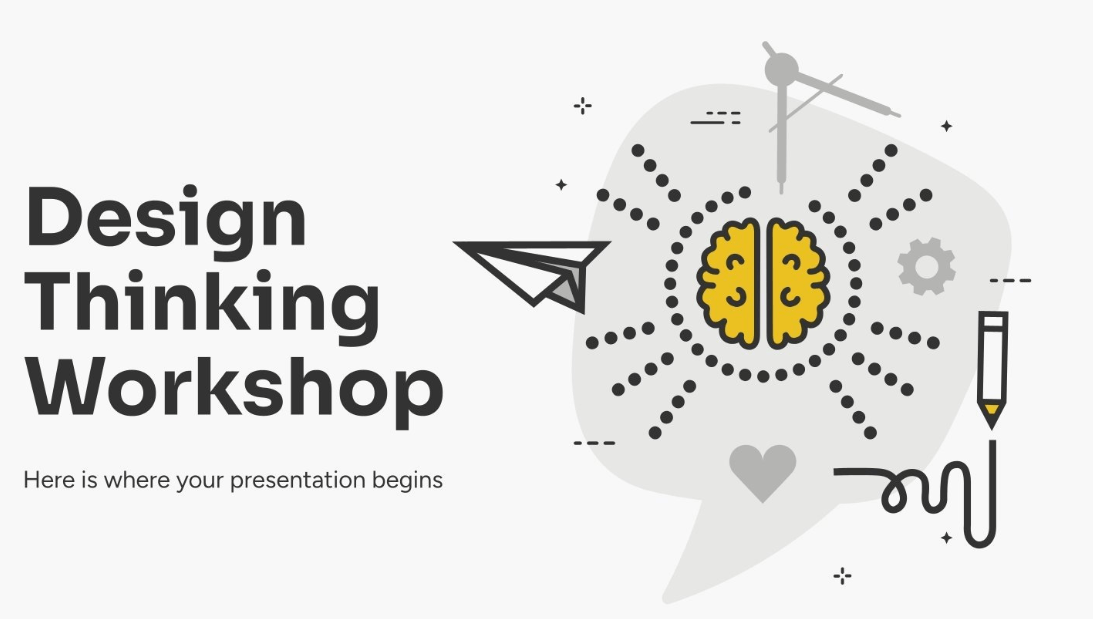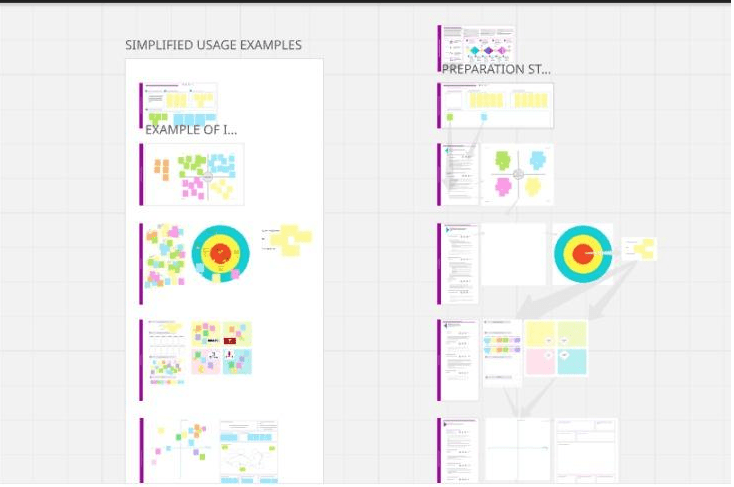Free Design Thinking Workshop Templates for Collaborative Sessions

Sorry, there were no results found for “”
Sorry, there were no results found for “”
Sorry, there were no results found for “”

Ever hosted a brainstorming session that felt more like a chaotic free-for-all than a productive workshop? Many teams struggle to turn creative ideas into actionable solutions due to a lack of structure and collaboration.
🔎 Did You Know? 60% of employees say that they feel more innovative when teams collaborate and stay aligned.
That’s where design thinking workshop templates come in. These pre-built frameworks help organizers guide teams through the design thinking process in a goal-oriented way. Think of it as your roadmap to innovative and collaborative problem-solving.
Whether you’re solving a customer pain point, improving a product, or reimagining a service, a solid template ensures every team member is aligned, engaged, and focused.
Let’s find out what design thinking workshop templates are, how to choose one, and the top templates you should explore to sketch out your design thinking workshop plan.
Design thinking workshop templates are pre-structured guides that help teams run collaborative, solution-focused sessions using the design thinking methodology.
They break the process down into manageable steps, enabling teams to understand problems deeply, ideate effectively, and prototype with purpose.
Standard elements include:
📮ClickUp Insight: 30% of workers believe that automation can save them 1–2 hours per week, while 19% estimate it could free up 3–5 hours for deep, focused work.
Even those small time savings add up: just two hours reclaimed weekly equals over 100 hours annually—time that could be dedicated to creativity, strategic thinking, or personal growth.💯
With ClickUp’s AI Agents and ClickUp Brain, you can automate workflows, generate project updates, and transform your meeting notes into actionable next steps—all within the same platform. No need for extra tools or integrations—ClickUp brings everything you need to automate and optimize your workday in one place.
Design thinking workshop templates keep the team focused, engaged, and productive, turning messy discussions into structured innovation.
Here are some of the best design thinking workshop template examples to help your team brainstorm creative ideas, solve real problems, and better understand customer needs:
Hosting a successful design thinking workshop requires meticulous planning and organization of everything from goals and reference materials to attendees.
The ClickUp Workshop Agenda Template helps with a structured format, making it easier to plan an effective design thinking workshop agenda.
Plus, with ClickUp’s powerful suite of design tools tailored specifically for creative teams, you can enhance collaboration and boost overall creative productivity—all in one place. This way, your team can focus less on juggling logistics and more on delivering innovative, user-centered solutions.
🔑Ideal for: Facilitators, UX designers, product teams, and educators looking for a structured way to organize design thinking workshops.
💡Pro Tip: Want to ensure efficient brainstorming at every stage of the design thinking process? Explore these design thinking tools to ideate and implement your ideas effectively.
Seeking a structured way to manage workshop attendee details and plan effectively? The ClickUp Virtual Workshop Registration Template streamlines planning and organization with customizable fields and a structured format.
It allows you to create customized workshop registration forms with questions such as participants’ questions, specific problems, and more, so you gather all the necessary details from every participant.
With this template, you can also send post-workshop surveys and analyze the responses to identify areas of improvement and what went well.
🔑Ideal for: Organizers who want to conveniently gather the details of the virtual workshop attendees.
➡️ Also Read: Design OKRs Examples to Reach Your Design Goals
The ClickUp Workshop Application Form Template ensures consistency in the information collected from the workshop participants.
It allows you to create forms tailored to the event requirements, such as job title, work email, and any relevant ideas or questions they may have, ensuring that all required information is collected from team members.
The details will be automatically filled in the appropriate fields, eliminating the need for manual work and errors.
Such an application process based on the design thinking approach ensures that the right team of like-minded individuals is assembled for the brainstorming session.
🔑Ideal for: Facilitators and teams looking to organize the attendee details of a design thinking workshop.
Planning, structuring, and managing design thinking workshops will never be complex with the ClickUp Training Framework Template.
Once you’ve determined the objective of the design thinking workshop, the template helps you organize the material, team members, and workshop timeline seamlessly.
Track progress and evaluate effectiveness with recurring tasks, and plan the workshop timeline from brainstorming and ideation through execution and testing.
🔑Ideal for: Teams and educators looking for a structured format to organize participants, activities, and resources of a design thinking workshop.
➡️ Also Read: Best Online Employee Training Software
Maintain consistency in planning and organizing design thinking workshops with the ClickUp Trainer Notes Template. With dedicated sections for every activity and a timeline of the workshop, the template ensures that all the necessary details are in one place, so nothing gets missed.
Add custom attributes to manage your training notes and easily visualize progress in each training session. Additionally, incorporating images and icons enhances the document’s visual appeal and maintains crisp formatting.
🔑Ideal for: Trainers and educators who want a structured document to list the workshop timeline, objectives, learnings, and feedback.
➡️ Also Read: Best Design Feedback Tools for Creative Teams
Ensuring that the product idea aligns with every team member is essential to ensure seamless collaboration and working. The ClickUp Design Ideation Template facilitates collaborative brainstorming and idea structuring among your team.
Collaborate with team members to brainstorm ideas and create content using this whiteboard template. The template ensures effective ideation, from concept generation to narrowing down ideas to achieve the desired outcome.
Set the estimates for the timeline, and use automation to ensure every activity is completed on time.
🔑Ideal for: Teams looking to brainstorm and organize ideas together.
➡️ Also Read: Brainstorming Templates & Techniques
Experiencing chaos, confusion, and a lot of back and forth when organizing design thinking workshops? Consider the ClickUp Squad Brainstorm Template, which is designed to remove complexity and make team collaboration seamless.
The template’s whiteboard format makes it simple for the team to present as many ideas as they can think of and brainstorm them with their teammates.
With sticky notes, images, website cards, shapes, and text boxes, you get to create categories for every idea. Additionally, color-coded boxes and notes facilitate navigation, and connectors simplify the definition of relationships.
🔑Ideal for: Team leaders and creatives who want to organize tasks for the whole team and ensure the timely completion of the objectives.
➡️ Also Read: How to Write a Design Brief
Understanding customer needs and aligning ideas and processes can be complicated, but not with an organized format like the ClickUp Empathy Map Whiteboard Template.
The template helps teams brainstorm customer pain points and categorize them for seamless analysis. Additionally, use sticky notes and text boxes to add all relevant information and customer experience research.
Plan the questions to be asked of the users, analyze patterns, and discuss ideas with the team to find the right solution, all in one place.
🔑Ideal for: UX designers and product teams looking for a tool to evaluate customer pain points and ideate solutions.
To develop innovative solutions, you must understand your ideal customer’s preferences, and the ClickUp User Persona Template helps you build that ideal persona.
Whether launching a new product or trying to improve an existing one, the template makes it seamless to define customer needs.
🔑Ideal for: Marketers and product teams looking for a structured approach to building customer personas.
Visualizing user flows is seamless with the ClickUp User Flow Template.
The template helps you understand how users interact with your product or website, and identify areas of improvement.
Teams can use this template to keep everyone on the same page when it comes to visualizing user journeys and optimizing customer experience.
🔑Ideal for: UX designers, marketers, and product teams who want to enhance the user journey.
🧠 Fun fact: The Human brain takes only 13 milliseconds to process images, and it processes images 60,000 times faster than text formats.
The most effective way to enhance services is to gather customer feedback and pinpoint areas for improvement. However, organizing the input is complex; it can easily get lost in numerous chats.
The ClickUp User Studies Template offers a seamless structure for every step, from collecting feedback to organizing it and finding solutions.
This way, your team can turn raw feedback into actionable improvements, prioritize the most pressing issues, and continuously enhance the user experience with clarity and efficiency.
🔑Ideal for: UX designers and product teams looking to get customer experience insights and brainstorm solutions.
Want to conduct usability tests? Use the ClickUp Usability Testing Template, which helps you manage the entire process seamlessly and organize the feedback to find efficient solutions.
Define the steps users should follow for efficient usability testing of the required feature, and ask them to provide feedback or add screenshots. Include an About Me section and feedback sections for each step.
This whiteboard template ensures you can gather important feedback to design offerings that truly delight your customers.
🔑Ideal for: Product teams who want to get customer feedback on new developments and make further improvements.
Usability testing involves a series of carefully planned steps, from defining the target audience and identifying the ideal sample of people to gathering feedback, analyzing it, and more.
Seems complicated? However, this is not the case when you have a structured approach, such as the ClickUp Usability Testing Plan Template.
🔑Ideal for: UX designers and teams looking to devise a usability testing plan efficiently.
💡Pro Tip: Looking for a structured approach to identify pain points, simplify design, generate ideas, and test them? Consider these usability testing templates and make the testing more productive and efficient.
Understanding your customer is easier with the ClickUp Problem Statement Template. It helps you draft the survey to collect details about the customer, what they want to achieve, the problems they are facing, and their feelings.
It lets you send automated surveys to customers for design feedback, and, when customers complete the survey, categorizes problems to facilitate easy analysis.
The template also helps you organize the input and find the ideal solutions.
🔑Ideal for: Researchers who need a structured way to collect, analyze, and act on customer feedback to improve user experiences.
Before you begin with a design sprint, you need a comprehensive document that outlines the plan. Any misses in the plan lead to confusion and errors. The ClickUp Design Sprint Template helps to avoid those errors.
The Folder template enables you to create distinct documents listing all necessary details for each step of the design thinking process. It also clearly defines the roles of each member, from note-takers to marketing experts and tech experts.
Set up triggers to move tasks to different lists, including map, sketch, decide, prototype, and test.
🔑Ideal for: Product design teams looking to brainstorm creative ideas and execute them in an efficient sprint.
➡️ Also Read: Design Thinking Process Steps & Examples
So you’ve hosted your first design thinking workshop and now need feedback to identify strengths and areas for improvement. Try the ClickUp Workshop Feedback Survey Template, designed to help you do just that.
It allows you to organize all feedback in one place, using cards to ensure comprehensiveness and easy understanding. Leverage the input received to enhance your next workshop plans.
🔑Ideal for: Workshop organizers, facilitators, and trainers looking to gather feedback after workshops and find optimization opportunities and points.
➡️ Also Read: How to Create an Effective Graphic Design Workflow

The PPT Design Thinking Workshop Template by Slidesgo makes planning a design thinking workshop simple. The template’s visually appealing format offers an engaging way to brainstorm and learn.
This downloadable design thinking workshop template can be saved in Google Slides, PowerPoint, or Canva. Add as many slides as you need or make adjustments to the existing ones based on the design thinking project to ensure an effective session.
🔑Ideal for: Design teams who want to organize a productive design thinking workshop

Want to move from just a concept to a proposal? The Design Thinking Workshop Template by Miro supports each step in the process.
It allows you to select the most suitable method from the multiple options listed and proceed with brainstorming ideas to find the right solution for each aspect.
Whether you want to create a prototype or presentation, interview people, try affinity mapping, build a Difficulty/Importance matrix, create empathy maps or others, the template makes it seamless and structured.
🔑Ideal for: Design and product teams looking to find innovative solutions to customer concerns.
A design thinking workshop template supports your goals and is easy for participants to follow.
Here’s what you should look for when choosing a design thinking workshop template:
Design thinking workshop templates offer an efficient way to brainstorm creative ideas, analyze customer needs, discover solutions, test them, and refine them.
Whether you’re launching a new product and want to assess the customer experience or want innovative ideas to meet user needs better, these templates streamline the creative thinking process.
ClickUp, the everything app for work, makes planning and organizing design thinking workshops easier. With collaborative tools and customizable templates, ClickUp brings clarity without limiting creativity, helping teams collaborate, stay aligned, and make faster, smarter decisions grounded in real-life user insights.
Turn scattered ideas into structured solutions. Sign up for ClickUp today!
© 2025 ClickUp